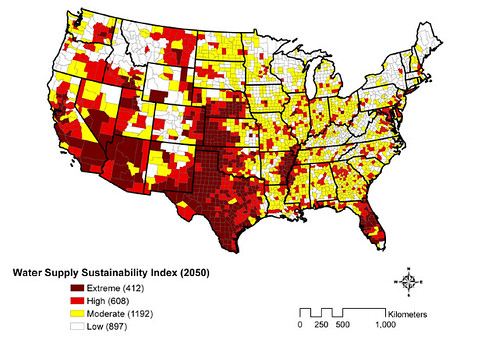
Greg Harman
Population growth, rising temperatures, and changing rainfall patterns are poised to wreak havoc on the country's water supply, leaving one in three counties facing high risks of water shortages by 2050, according to a report released this week by the Natural Resource Defense Council.
And the study, which bases its findings on population trends and leading international climate models, places Texas at center stage of those expected shortfalls. Already in many areas of the state more water is being withdrawn from surface and groundwater supplies than is returned. Factoring a near doubling of the state's population, loss of an inch of rainfall per year from changing weather patterns, and adding a nearly three-degree rise in average temperatures by mid-century expected to cook off another five to seven inches of rainfall through increased evaporation rates would place most of the state at “extreme” risk of loss of water sustainability, the researchers found.
“Water shortages can strangle economic development and agricultural production and affected communities,” said Dan Lashof, director of the NRDC's Climate Center, said in a prepared release. “As a result, cities and states will bear real and significant costs if Congress fails to take the steps necessary to slow down and reverse the warming trend.”
 That the Texas of the future will be a much drier place is not exactly new information. The Texas Water Development Board wrote in its 2007 State Water Plan states that as we add another 20 million residents by 2060 water demand is expected to grows by 17 percent, mostly in the cities. And Texas will have about 22 percent less of the wet stuff to pass around. As daunting as that sounds, the TWDB's chapter on climate doesn't even mention the anticipated impact of global climate change now underway.
That the Texas of the future will be a much drier place is not exactly new information. The Texas Water Development Board wrote in its 2007 State Water Plan states that as we add another 20 million residents by 2060 water demand is expected to grows by 17 percent, mostly in the cities. And Texas will have about 22 percent less of the wet stuff to pass around. As daunting as that sounds, the TWDB's chapter on climate doesn't even mention the anticipated impact of global climate change now underway.
While a natural drying is already occurring across the Western U.S., the impact of human-induced climate change â?? expected to upset rainfall events and increase temps by seven degrees this century if unaddressed â?? is a complete game-changer.
When I was writing on climate predictions and Texas (“Last Chance for a Slow Dance?”) more than a year ago, Richard Seager, a Doherty Senior Research Scientist at the Lamont-Doherty Earth Observatory of Columbia University in Palisades NY, suggested that folks in the Southwestern U.S. and western half of Texas should be settling in for a nice long spell of “permanent drought.” `You can listen in on our 20-some-minute discussion about megadrought.`
NRDC contracted out their most recent study to Tetra Tech, a research outfit frequently employed by the Feds. In creating their rankings of all U.S. counties, Tetra Tech evaluated projected water demands, precipitation levels, susceptibility to drought, and projected summer water deficits. Changing precipitation patterns were also a key factor.
The group draws on a variety of climate models to project future conditions, including data from the U.S. National Oceanic and Atmospheric Administration, NASA, the National Center for Atmospheric Research, and research centers in Japan, Germany, Australia, Canada, United Kingdom, France, and Russia.
In the coming month, water districts across the state will be hustling to finish up work on their Desired Future Conditions reports due September 1. These documents will be used by the TWDB to fashion the state's next State Water Plan. Considering the forecasts, residents across the state may want to press for the most conservative scenarios possible. While weather is a funny thing, and Texas weather especially quixotic, I have yet to find any suggestion that the clouds on the horizon are bringing anything but sad dust and mesquite thorns.
If you're interested in how the groundwater for Bexar, Bandera, Blanco, Comal, Hays, Kendall, Kerr, Medina, and/or Travis counties is being managed, we humbly suggest you descend on Boerne at 10 a.m. Monday when Groundwater Management Area 9 holds their next DFC meeting (PDF). Your future self will thank you.


















